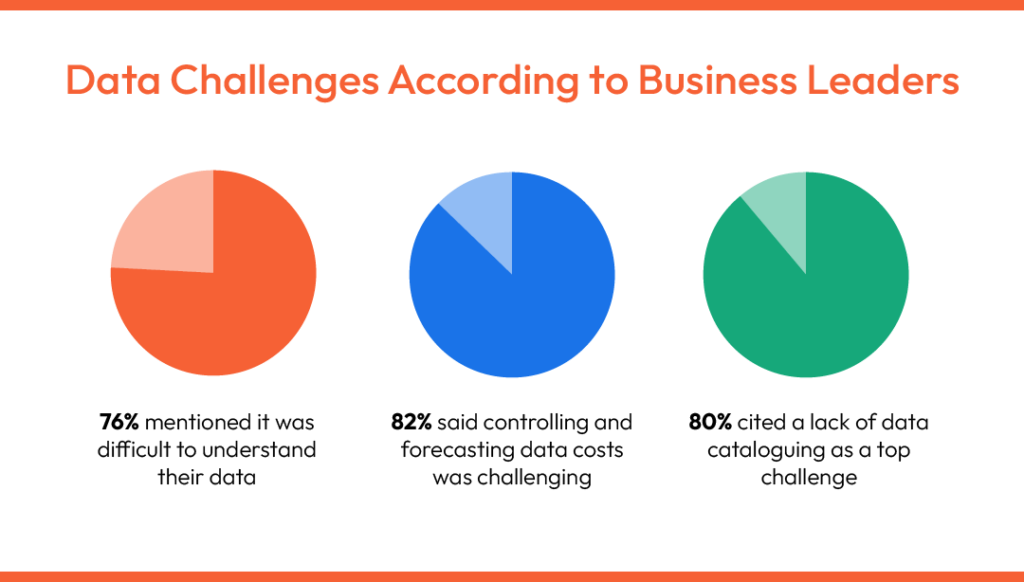What will data management challenges and applications look like in the cloud space in 2024? It's all about the cloud, CDMC and CDMI.

Data management is an absolutely crucial aspect of running a successful business in the modern era. Without data, most companies would have difficulty keeping up with the competition or even being able to effectively serve their customer base in a way that ensures repeat business and retention of loyalty at any level.
With each passing year, data management evolves. According to this Forbes article , 76% of business leaders surveyed found it difficult to understand their data. The same article goes on to state that 82% of data management decision makers reported that predicting data costs was a challenge and 80% of decision makers interviewed stated that a lack of talent was the biggest obstacle.

Source: Forbes
Another important number is 77.6 billion dollars which, according to Zipdo , is the value at which the global data market will be valued by 2025. This demonstrates the growing relevance of data management. With this assessment, you would expect most companies to recognize the power of data-driven decisions, but it may come as a surprise to learn that this is not the case. This 2017 Harvard Business Review study showed that, on average, less than half of an organization's structured data is actively used in decision-making and less than 1% of unstructured data has been analyzed or used.
How have times changed?
As data continues to serve as the lifeblood for many aspects of your business, you should consider it an absolute necessity to stay up to date. While your internal data stores may be serving you well at the moment, you should always think a few steps ahead. Otherwise, you might also consider yourself late.
As data continues to grow, many companies are doing the same thing, moving from in-house data centers to the cloud. If you haven't already migrated your data, it's time to do so. Such a migration may be daunting at first, but in the end, it will be worth overcoming the challenges.
But what are the advantages and disadvantages of transitioning from traditional data storage to the cloud? Let's dig deeper and find out.
Advantages of Cloud Data Management
First, let's look at the advantages of cloud data management. Here are the top pros for making this change.
Security
When you migrate your data to a cloud management platform, you gain security improvements that can only be offered by a company that has a vested interest in the security of your data. Additionally, you will also find that cloud data management platforms are superior in preventing data loss. Unless your company employs a team of data scientists and data security experts, there is no way your team can achieve the level of security offered by a cloud data management platform.
Scalability can solve many problems
Your internal data center is limited in terms of scalability. The only way around this is to purchase expensive hardware and then deploy the new hardware so that it works seamlessly with your current servers. This can be challenging depending on the database server used.
Even better, with a cloud data management platform, you gain automated scaling functionality. This means that not only will your data platform always be able to meet an increase in demand, but it can also scale back when demand decreases, saving you money (since you only pay for what you use).
Controlling who has access to your data
A very important benefit of a cloud data management platform is that it allows you to control who has access to your data. Those who have access will be able to work with this data from anywhere. This means you can hire teams from anywhere in the world, give them access to the platform, and trust that they will be able to successfully work with the data and even collaborate with other teams.
Backups and recovery are crucial to continued success
Like most cloud platforms, backup and recovery is not only considerably easier than in the on-premises data center, but it can also be automated. And with most cloud data management platforms, you can even automate the download of backup data to local storage. With a backup of your data stored at your company, you can be sure that there will always be a working copy of the data to be used in case of an emergency. Of course, the chances of you needing this backup are probably slim, as cloud data management platforms tend to be solid.
Clean data equals trustworthy data
Most cloud data management platforms work with data silos and a single source of truth for your data. This means your data is not only more reliable, but also cleaner and continually updated. Because these platforms work to keep your data clean, you will have more power to use this data for various purposes (such as ML, AI, and external third-party software).
Keeping it Green
If your company is concerned about keeping its carbon footprint low (and it should be), moving to a cloud data management platform can go a long way toward helping that cause. Most cloud data management companies have to operate under certain laws and climate legislation, which means their carbon footprint is already much smaller than it would be otherwise. And when you migrate, you're doing your part to follow suit.

Disadvantages of Cloud Data Management
In fact, there aren't many downsides to moving to a cloud data management platform. Still, here is the list of major cons.
Third-party access
Even with all the advantages, some companies don't like the idea of hosting their data on a third-party service, where non-company employees can have access to confidential data. Although the chances are slim that someone from a cloud data management company will use your data against you, it is still a risk. If privacy and data security are at the top of your list, this is something you should consider.
Vulnerability to attacks
While the security of cloud data management platforms tends to be considerably better than that of your in-house data center, these services tend to have targets on their backs. Hackers know that cloud data management platforms offer a veritable treasure trove of information, so they are always looking for new ways to infiltrate these systems.
That doesn't mean they will succeed, but it does mean they are regularly under attack. If these hackers find a vulnerability to exploit, they can gain access to your data.
Could be the operative term.
Vendor lock-in
Finally, when moving to a cloud data management platform, you may be stuck with the tools that the platform uses. If the company doesn't offer the tools that its administrators are accustomed to using, there may be a learning curve involved. And if your developers find tools they'd like to employ, that cloud data management platform might not support them.
This can be especially problematic if your developers have created custom applications for you to use. If your cloud data management platform doesn't have APIs to connect these custom applications, you might be out of luck.
Best Practices
Now that we've clarified the pros and cons, let's mention some best practices that your company should follow to have a successful cloud data management experience.
Have a plan and stick to it
From the beginning, it is crucial that you begin the migration process with a plan that ensures your migration is successful. As you create this plan, ask yourself the following questions:
- Will you need a public, private or hybrid cloud environment?
- Who will need access to the data?
- What processing tasks will your data require?
- What type of database does your data work with?
- What tools do you need for a successful migration?
- Can you make the migration while keeping your business running before “turning on the switch”?
Answer these questions and formulate a solid plan before making the migration.
Maintain healthy data
No matter where you store your data, it must always be intact. This means it must be valid, complete, and follow best practices for the database server software you use. You should look into your chosen cloud data management platform and make sure it includes a data cleansing tool. If not, you may need to work with this tool before making the transition. Remember, clean data equals healthy data.
Backup, Backup, Backup
Even though you have 100% confidence in your new cloud data management platform, it is still absolutely essential that you make regular backups of your data. Your chosen platform probably includes backup tools, but you should configure them so that your data is backed up daily (at best) or weekly. Remember, if your data backup is not up to date, it is out of date, which means you could be missing crucial information.
Data management
You must develop a solid data governance policy, which will include necessary compliance issues. If your data is related to healthcare, there are very specific compliance needs. If you are working with government entities, the same thing applies. It is important that you fully understand any and all compliance issues related to your data and ensure that you are always compliant. And because you're moving your data to the cloud, there will likely be additional compliance issues you'll have to deal with.
On top of all this, compliance is not a static issue. Compliance laws are always changing, so it's critical that you stay up to date on these laws so you don't have to worry about being out of compliance.
Conclusion
Migrating from an on-premises database solution to a cloud data management platform can be a tricky business. But with the benefits gained, the headaches you may suffer before and during the migration will be worth it.
Have a plan, stay up to date, back up your data regularly and stay compliant and everything will go smoothly.




















































